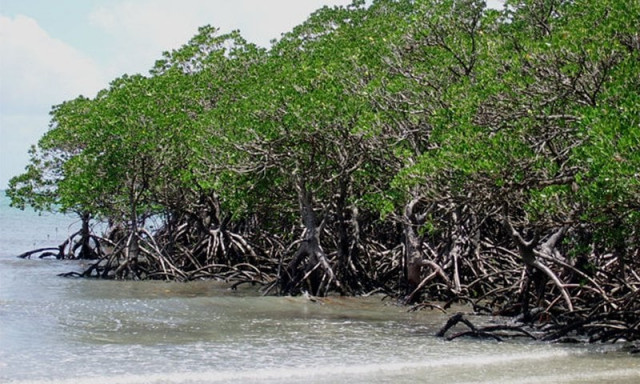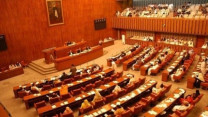‘Shield the Mangrove’: The effects of mangrove deforestation in Sindh’s coastal regions
Loss of mangroves in coastal areas are resulting in a reduced reproduction, procurement of commercially important fish

ABSTRACT:
The Mangrove swamps of Sindh’s coastal zone are extensive, covering ~600,000 hectares, 95% of the total mangrove population of the country. Today, as per estimates, mangroves are on continuous decline as deforestation takes place at an alarming rate and reforestation does not, at the same level. Approximately less than 6% of Pakistan’s land is covered by forest and less than 3% of that is mangroves. This means that less than 0.002% of Pakistan’s land is covered by mangroves. Pakistan’s climate is ideal for mangroves, as they thrive in warm climates, however Pakistan does not enjoy the same benefits a mangrove dense country such as Brazil or Indonesia do. The forests have remained ignored and their potential has been largely neglected in Pakistan.
Due to urbanization and industrialization, the growth of Mangrove shrubs has also been affected. What’s worse is that people living along coastal areas are not aware of the benefits of mangroves to their own livelihood, especially the fishermen, and the fish market as a whole.
Schemes such as ‘Environmental Protection and Management project’, ‘Mangrove Plantation for rehabilitation of Korangi-Phitti creek system’, ‘Development of Mangrove forests in the Indus Delta’, ‘Working Plan of Mangrove Forests of Indus Delta from 1985-2005’; with regional cooperation in the UNESCO/ADB/IUCN/UNDP and many other agencies have helped in restoration, but various national and international agencies have reported a substantial reduction in the extent of mangroves, both in area and density.
If correct measures by the government and industries at grass-root level are not taken in the near future, Mangroves could be in danger of becoming extinct in Pakistan, causing damage to the environment and the economy, both.
INTRODUCTION:
The Indus Delta Mangrove forests have become monoculture, and according to Flora of Pakistan, out of eight species which were reported to be found along the coast of Pakistan, four species have completely disappeared. Moreover, three species are at the verge of extinction and only one species, the Avicennia Marina, survives in the Indus Delta.
The loss of Mangroves in coastal areas are resulting in:
a) a reduced reproduction and procurement of commercially important fish
b) loss of livelihood and declining health of communities (particularly women, children and elders dependent on fish-based products as a primary source of sustenance)
c) increased coastal erosion, damage to coastal villages and agricultural land through salt-water intrusion and contamination
d) reduced availability of wood, loss of faunal and floral biodiversity, and the silting up of navigational channels and ports.
Another economic benefit that as a country we are not able to fully leverage is the millions of rupees mangroves save through maintaining the terrain of the coast and along the ports. For a city like Karachi, which was ranked the 23rd most polluted city in the world by CBS News, the efficiency of mangroves in absorbing carbon dioxide (18% more than other plants) also plays a key role. It is time to design and develop an ecologically feasible and community approved mangrove afforestation and conservation project to meet the guidelines of MTDF, and align it with the objectives of Pakistan Millennium Development Goals (MDGs) for a sustainable economic outcome, aimed at reducing poverty in the coastal tract, and also protecting existing forest cover and eco-system. Regeneration of deforested areas and bringing new areas under forest cover is the need of the hour.
This paper aims to highlight the issues that can negatively impact the environment due to Mangrove deforestation along the coastal belts of Pakistan, particularly in the Sindh region.
DISCUSSION:
Urbanization and Industrialization:
Without realizing its global and national impact, mangroves in Pakistan are being reduced unchecked in Sindh due to urbanization and industrialization pressures. Reduced water flow in the River Indus (the sixth largest river in the world) after the construction of dams and barrages upstream are also causing reduction. Over the last five decades, mangroves have been subjected to over exploitation and huge population stresses, and its harmful effects to nature and the environment are imminent. Further, there is a reduction in fresh water supply and an increase in marine water pollution, coming from none other than the industries, as well as the ‘oil spills’. All of this causes overall coastal erosion, usually considered the immediate cause of mangrove loss in Pakistan.
Lack of Awareness:
Similarly, the significance of mangroves in terms of ecological and economic value have not been effectively understood and communicated and they continue to be considered wastelands as far as larger population is concerned. Strong planning with the collaboration of local institutes at grass-root level will be helpful to strengthen the capacity of local communities living in coastal regions to gain knowledge of the issue at hand, and to achieve the targets of reforestation easily, however progress on this has remained dismal. If done properly, this will also be instrumental in achieving the conservation goals in a sustainable manner with windfall of increase in the resources in coastal areas, resulting in economic benefits to local people.
Sustainable Solutions:
To stop the degradation of mangrove areas, the World Bank, back in 1999, had suggested that the mangroves forests in Pakistan be protected by declaring the Arabian Sea coastal areas a national park. This sort of sustainable solution will have important effects on the environment in the longer run.
Since 1980, a 25% global reduction in mangrove area has been observed, categorizing mangrove as one of the most threatened and vulnerable ecosystems of the world. Pakistan is home to five of the world's largest mangroves and receives special attention for their ecological importance and coastal stabilization potential. No major studies have lately taken place to gauge the extent of mangrove cover at the end of second decade of 21st Century.
Failure in Comprehensive Assessment:
The climate of Pakistan is tropical and is dominated by the monsoon regime. The average rainfall on the coast of Sindh amounts to about 200 mm. . The south-west monsoon season lasts from May to September and the North-east lasts from November to March, with April and October being the transition months. There is an increasing trend in the frequency cyclonic disturbances with fluctuations. No definite trend has been observed in case of cyclonic storms and severe cyclonic storms. Moreover, the short periods of fluctuation of 2-6 years are predominant. Anthropogenic and climatic influences, along with slack institutional management, have raised questions about qualitative and quantitative deformation of the country's mangrove resources and no major study has been conducted to understand the impact of climatic changes on mangroves.
How are Mangroves Being Saved?
Related organizations, government agencies and non-governmental associations have already begun to take steps and are making evident efforts in opening new Mangrove nurseries in Sindh. Besides Karachi plantations, efforts are also being made to grow more timber plantations and creating awareness amongst communities on the significance of mangroves for livelihood, purposefully making them take the ownership for not protecting mangroves enough.
What is the MFF program?
The Mangroves for the Future (MFF) is a program that aims at promoting sustainable coastal development through participatory and inclusive decision making for facilitating ‘strategic investments’ in coastal ecosystems. For a country like Pakistan, inclusion in MFF opens up a number of exciting opportunities for both positively participating in ‘region wide’ initiatives and in prioritizing actions to effectively mobilize critical national stakeholders and resources for visioning, implementing and sustaining a viable national coastal management regime.
There is now a growing recognition in Pakistan that sustainable coastal management can only be realized through the adoption of an ‘Integrated Coastal Management (ICM)’ process. Within this context, MFF creates an extremely viable and well-coordinated effort for facilitating progress towards establishing a ‘National ICM regime’ for Pakistan as the intended approach and focus addresses key gaps and constraints hindering desirable progress.
International Conventions to protect Environment/Biodiversity:
A study by the WWF indicated that 65% of litter on coastal areas consists of plastic bottles, wrappers, bags, disposable utensils and straws. Additionally, Karachi lacks proper waste management systems and regime, ultimately finding destinations into the sea. The fish and other marine life swallow these tiny particles of metals, plastics and poisonous substances that become fatal to their survival. So what is being done for this?
Pakistan has signed many international conventions and treaties to protect environment and biodiversity. Under these obligations, Pakistan has committed to protecting its marine and coastal biodiversity. Some of these include Paris Agreement, Convention on Biological Diversity (CBD), Convention on Trade of Endangered Species (CITES), RAMSAR Convention, Kyoto Protocol, United National Convention on Law of Sea, Basal Convention and the Stockholm Convention.
In the past, Pakistan has taken initiatives including establishment of the Marine Pollution Control Board, National Institute of Oceanology and formulation of Pakistan National Strategy and Action Plan. Above all, recently Pakistan declared Astold and Churna Island as the first protected marine areas of the country. However, the efforts are not enough to overcome all the challenges. Still, environment and biodiversity of marine and coastal areas are confronted with many unnoticed threats that require due and timely attention from the government, the private sector and common people.
METHODS AND MATERIALS:
The first step to conserving mangroves and carrying out a plantation program is to set clear objectives, which fall into the following categories:
• Sustainable timber production
• Coastal/shoreline protection
• Channel stabilization and conservation
• Support of ecological functions for shrimp and fish contribution (to fishery production)
• Ecological restoration
• Landscaping/enhancement of aesthetic quality of the landscape
Secondly, site conditions also need to be kept in mind. Attention must be focused on the selection of a suitable planting site, followed by selection of appropriate species and best-suited planting technique and time for the given site. Site selection should further be based on an analysis and understanding of historic changes and natural processes. The primary aim of a mangrove management strategy should be to maintain the health of the remaining mangrove ecosystems (thereby improving their resilience) and to reduce the rate of mangrove loss. This is often more effective than trying to plant new mangroves and is less expensive than other approaches.
Awareness is rising about the importance of mangrove ecosystems and involvement of local communities in their management can contribute to better protection however this needs to be further embedded. Further, three types of mangrove-planting can be employed: reforestation, rehabilitation and restoration. In addition, afforestation is used in sites where mangroves have not grown in the past. A detailed plan of operations should be prepared before planting starts, including a description of the site and if necessary, the proposed restoration measures including:
• Species to be planted
• Planting techniques and timing
• Zonation of planting
• Numbers and quality of the seeds being used
• Propagules or seedlings required
• Work schedule
• Equipment and budget
• Monitoring plan
The whole activity needs to be owned by Federal as well as Provincial authorities with clear accountabilities on progress. It is extremely important to also institutionalize the initiative for continuity of focus and results in the long-run.
CONCLUSION:
There is a dire need for integrated planning and management, based on sound legal principles. Conserving existing mangrove forests is often more effective than planting new forests. There should be proper and careful selection of appropriate sites and species and an eco-system based approach to mangrove planting and management, which uses and supports natural regeneration and other natural processes.
Involving local communities, on the other hand, in mangrove management is an effective way of maintaining and enhancing the protection function of mangrove forests, while also providing livelihood for local people and contributing to better assessment and governance of natural resources. Assessment of the status of mangrove forests is essential for better conservation planning and management. This also includes the research and economic assessment and valuation.
In my observational surveys, I discovered upon visiting areas of Korangi and Lyari that families faced problems due to deforestation, mostly in the form of eroded soil and the non-salinity of water. Many families also had to relocate/migrate elsewhere, losing their livelihood in the process.
In the long run, alternative means of planting and conservation of mangroves will be very important, otherwise detrimental effects will be caused to the environment, as well as humans and animals living off of the benefits of these very important coastal shrubs.
The Sindh government should further pursue establishing firm laws and making sure they are implemented, and action is being taken to conserve the Mangrove forests.
– Author is a student of A-Levels (Senior Year) at Karachi Grammar School









1733130350-0/Untitled-design-(76)1733130350-0-208x130.webp)









COMMENTS
Comments are moderated and generally will be posted if they are on-topic and not abusive.
For more information, please see our Comments FAQ